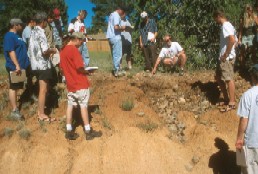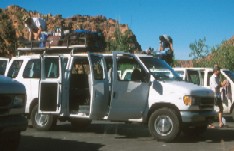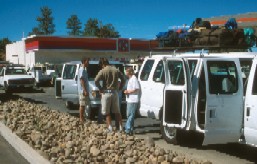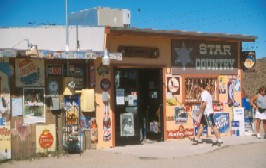 day,
taking cat naps when possible.
day,
taking cat naps when possible.
Personally, I’ve come a long way with the camping thing since three years ago when we experienced our first cold and rainy night at Ten-X campground south of the Grand Canyon. I recall that morning three years earlier when I groggily exited my tent to see Lee looking at me, and I said to him “Now I know why I quit the boy scouts”. He had a hearty laugh over that one, and from that point on he realized that camping is not exactly my favorite activity. Since then he asks me once in awhile how it’s going, and now I can tell him that I’ve actually been enjoying myself. The good weather helps – boy have we been lucky! The final trip was my best camping experience yet in the field class. In Utah I was fairly efficient with setting up, and fairly relaxed about camping. Especially the last two of the three nights I slept fine – the air mattress was well worth the effort – I can’t take sleeping on a hard surface very easily – I know, what a wimp. Well, that’s the way it is, and if I can make myself more comfortable, I will do so. For me, not to get enough sleep is miserable, and probably a hazard when I’m driving all day long in the van. At one point, Lee commented that I seemed to be having more fun than normal, and I had to agree. Camping’s ok, and I actually look forward to doing it again next year. Fortunately, it’s no longer “grin and bear it”.
Despite my own hang-ups over camping, the students have consistently taken to camping like fish to water. For three years they have, with few exceptions, adapted easily to the outdoors, a fact that I attribute to their enjoyment of the outdoors in the first place. I would hazard a guess that most of our geography students enjoy the outdoors and various outdoor activities more than many other students at NAU. Geography is a “natural” major for many of them.
 This year as in the past, Lee and I were impressed with the ease and efficiency
with which our students dealt with camping. They even have their
packs ready on the vans at an early hour. We have yet to force them
to “hurry up” if we’re not leaving a campsite on time. Lee had told
me personally in the past that as long as we’re out of there (the campsite)
between 8 and 9am, we’re doing fine, and the students have consistently
met his expectations every time for the last three years, even without
us giving them a deadline. They just do it. It does make life
easier for us and then.
This year as in the past, Lee and I were impressed with the ease and efficiency
with which our students dealt with camping. They even have their
packs ready on the vans at an early hour. We have yet to force them
to “hurry up” if we’re not leaving a campsite on time. Lee had told
me personally in the past that as long as we’re out of there (the campsite)
between 8 and 9am, we’re doing fine, and the students have consistently
met his expectations every time for the last three years, even without
us giving them a deadline. They just do it. It does make life
easier for us and then.
Lee was actually surprised to a point that the next two campsites – our first two in Utah – were actually just as nice as Fool Hollow, albeit in different environmental settings. He was impressed, and told me how great the sites were at the end of the course. Hopefully this will be a trend that continues. I have actually enjoyed organizing the trips, campsites, and other necessities for the field class, and my planning normally starts in February, trying to decide what kind of trips to take. We don’t like to repeat much from one year to the next, and this has led to our aforementioned experimentation with various trips.
The necessity of obtaining sustenance during the camping trips meant nightly stops at various grocery stores prior to arriving at camp. Usually following our last instructional stop for the day, Lee and I would seek out a grocery store in the town nearby to the campsite so that we and the students could purchase any food goods for the evening and next morning. On our first overnight trip, we arrived in Show Low at about 6pm following our final stop for the day at Snowflake. Driving toward the south end of town, we were eagerly waiting for a shopping complex to appear along Show Low’s lengthy and tedious commercial strip. First we were amazed that we had driven for literally miles through town and seen not one grocery store, though one student finally gave us confidence when he said that there should be one at the edge of town. Indeed, he turned out to be right, and I had never seen so many students express so much pleasure at finding a “Safeway” grocery store. They were thrilled, and until then I had no idea that they would be so dependent on shopping. On the first day, Lee had instructed students to develop their own “cooking groups” that would provide a stove and necessary food items and coolers. While some students did take this hard-core approach to camping, the rest of us (including myself) weren’t all that thrilled with the idea of cooking at camp. So the last stop of the day has traditionally become the nearby grocery store. These store stops in themselves were quite fascinating, given that we never knew what we would find upon arriving in each town.
 I still recall that night in Show Low. We gave the students about
20 minutes to get what they needed at Safeway. To see this big, modern,
air conditioned store while on a camping trip actually seemed somehow out
of place, sort of a return to “civilization”. Here, the class was
no longer on its own, but instead was mingling with regular local shoppers.
It was amusing to see. As I headed for the deli section to acquire
my obligatory turkey sub, students from our group criss-crossed through
the isles, darting around with their hand-held red shopping baskets, searching
for sustenance. One would fly by in one direction while another student
would zoom by in another. It was like they were in a candy store.
The funny thing for me was that aside from a typical sandwich at the deli,
I usually found little of interest to me – I already had drinks in my cooler,
and none of the junk food really looked all that appealing on this year’s
trips for some reason. So I kind of hung out around the deli, silently
wondering why I was refusing to find anything else in a store of this grand
size, a store that the Romans would be envious of with the incredible selection
of foods. For me, however, four nights of wandering grocery stores
with the students yielded little of interest. Partly, I was thankful
that I wasn’t going nuts running up and down the isle. I couldn’t
say the same for some of the other students.
I still recall that night in Show Low. We gave the students about
20 minutes to get what they needed at Safeway. To see this big, modern,
air conditioned store while on a camping trip actually seemed somehow out
of place, sort of a return to “civilization”. Here, the class was
no longer on its own, but instead was mingling with regular local shoppers.
It was amusing to see. As I headed for the deli section to acquire
my obligatory turkey sub, students from our group criss-crossed through
the isles, darting around with their hand-held red shopping baskets, searching
for sustenance. One would fly by in one direction while another student
would zoom by in another. It was like they were in a candy store.
The funny thing for me was that aside from a typical sandwich at the deli,
I usually found little of interest to me – I already had drinks in my cooler,
and none of the junk food really looked all that appealing on this year’s
trips for some reason. So I kind of hung out around the deli, silently
wondering why I was refusing to find anything else in a store of this grand
size, a store that the Romans would be envious of with the incredible selection
of foods. For me, however, four nights of wandering grocery stores
with the students yielded little of interest. Partly, I was thankful
that I wasn’t going nuts running up and down the isle. I couldn’t
say the same for some of the other students.
On certain nights some students actually had shopping carts, and their carts filled up pretty fast. They were on regular shopping expeditions, and I wondered what they would do with all that food. Also, I thought students were, naturally, supposed to be poor. Well, all in all the grocery stores we stopped at did quite well by us, and the vans filled up with various food stuffs, eventually overflowing the back seats of the vans. On the Utah trip, it became more of a challenge to retrieve my camping gear from under the back seat upon arrival at camp, as my gear competed with shopping bags and food loaded in all usable corners of the van.
Sometimes it was interesting to experience the stores in themselves, as we occasionally came across a store with a lot of character. Only this year did I recognize that the grocery store experience was a unique one for all of us, given that many of our stops are in rural areas with limited store selection. During our first night in Kanab, for instance, we stopped for gas and food at a small shopping center just outside of downtown. The grocery store was amazing, certainly a product of the 1960s, prior to the advent of today’s “superstore”. This was a locally owned store, it seemed, with thirty-year old cash registers and an old drop ceiling. The store was similar to the grocery stores that I remember from my home town in the 1970s, before they were acquired, expanded and updated by larger chains. The store in Kanab was a historical piece in itself, and due to its smaller size, it was easier to watch the students roam around choosing their purchases for the night. Several shopping carts were filled up as usual, and as a class we kept the few cashiers quite busy. Once again, the store did quite well by us. I exited once again with my usual fare: a turkey sub, a soda, and a long-coveted York peppermint patty.
One thing I learned to purchase regularly at these stops, aside from the turkey sub, was ice. By my side at all times in the van is a convenient, mid-sized blue soft-sided cooler with a plastic inner lining. I can typically fit two lunches, snacks, and numerous drinks inside it. Based on past experience, I’ve learned that having a cold drink on hand – even if it’s water – makes all the difference in the world while driving through arid and desert landscapes (duh!). So, a bag of ice twice a day, once at the morning “coffee stop” and once prior to arriving at camp, is a cheap but wise investment. Of course, other students purchase ice for their coolers as well, and it shouldn’t surprise anyone that the chances of ice spilling and melting on the van floor are typically quite high. Twice on our last camping trip, I recall the students opening the side door to exit the van and having water splash out, not unlike being at sea. Luckily, it’s just water, and in the temperatures and dry air through which we travel, such “mistakes” tend to evaporate quickly.
Other small town stores, in even more isolated places, are even more interesting. On the last day of our travels, for instance, we had visited Meadview overlook to view the Colorado River as it spills unceremoniously into Lake Mead from the Grand Wash Cliffs. It was hot, the students were anxious to head home, and Lee had already entertained us by flying some of his large rockets in the middle of a salt flat (playa), known as Red Lake. We were practically in the middle of nowhere, and lunch was needed. Just off the main road is the little town of Meadview, in which there exists a small general store that supplies the entire community. We’ve seen numerous stores like this one in the past few years, given our ventures into rather isolated places with rather dying towns. But this one was unique. I suppose they all are in their own way, simply because they are not the typical, antiseptic chain store where you can predict what food will be on which isle, no matter where the store is located. These little one-store towns have their own character, their own sense of place. Junk food tends to have dust on it, there are usually no more than two or three employees, and one of them is invariably the owner of the fine establishment. Most often these places are also packed – the isles are small, and there is a lot of merchandise on the shelves, usually not too well organized. Sometimes the store is set up inside several small rooms, so you have to wind your way through one section to another through narrow doorways, like the unpredictable little store in Dolan Springs.
 Well, returning to Meadview, this was a quintessential example of a typical
small town store in the rural Southwest. For the owner of the store,
our unannounced arrival was nearly overwhelming. Upon parking the
vans in the dirt parking lot on the side of the store, we all converged
on the narrow isles. Just imagine a small grocery store, hardly
space for two people to pass on any given isle, with some 25 college students
and professors wandering around trying to decide what to eat for lunch
and what to purchase for later consumption. It was more than amusing,
though it appeared the owner didn’t at first think so. This rough-skinned
guy in his 60s approached me (must have been my golf shirt and Penn State
baseball cap that gave me away) in one isle as I scanned the store, and
he tersely asked, “Are you the leader of this group?” and I replied, “one
of them,” and he said, “you know, I only have one other employee working
right now, and I just let off another one for a break, so we don’t really
have the people to help right now. If I had known you were coming
we could have been prepared”. I thanked him for thinking of us and
tried to convince him that we were not the type of group to complain about
service. We were geographers, and happy to be patient and self-sufficient
as much as possible. These students never gave anyone trouble, and
if they had to wait, they waited. So I told him, “that’s ok, we’re
not in any rush,” and he continued to tell me that if we came through again
to let him know ahead of time, and I replied that it was hard for us to
do that, what with being few “rock phones” out in the Cerbats range or
in the middle of Red Lake. How were we supposed to know when we’re
going to show up at a store like this? Anyway, he was probably more
concerned about having to work a little harder with all of us there than
he was with our ability to head on our way in a timely fashion, but I gave
him the benefit of the doubt.
Well, returning to Meadview, this was a quintessential example of a typical
small town store in the rural Southwest. For the owner of the store,
our unannounced arrival was nearly overwhelming. Upon parking the
vans in the dirt parking lot on the side of the store, we all converged
on the narrow isles. Just imagine a small grocery store, hardly
space for two people to pass on any given isle, with some 25 college students
and professors wandering around trying to decide what to eat for lunch
and what to purchase for later consumption. It was more than amusing,
though it appeared the owner didn’t at first think so. This rough-skinned
guy in his 60s approached me (must have been my golf shirt and Penn State
baseball cap that gave me away) in one isle as I scanned the store, and
he tersely asked, “Are you the leader of this group?” and I replied, “one
of them,” and he said, “you know, I only have one other employee working
right now, and I just let off another one for a break, so we don’t really
have the people to help right now. If I had known you were coming
we could have been prepared”. I thanked him for thinking of us and
tried to convince him that we were not the type of group to complain about
service. We were geographers, and happy to be patient and self-sufficient
as much as possible. These students never gave anyone trouble, and
if they had to wait, they waited. So I told him, “that’s ok, we’re
not in any rush,” and he continued to tell me that if we came through again
to let him know ahead of time, and I replied that it was hard for us to
do that, what with being few “rock phones” out in the Cerbats range or
in the middle of Red Lake. How were we supposed to know when we’re
going to show up at a store like this? Anyway, he was probably more
concerned about having to work a little harder with all of us there than
he was with our ability to head on our way in a timely fashion, but I gave
him the benefit of the doubt.
When most of us had left the store and I was waiting at the counter to purchase my ready-made turkey sub (the most awful, dry excuse for a sandwich I ever had – most of it got tossed, having spoiled my appetite), I got him talking about Meadview and his store. Interestingly, he was very proud of his little store, which he affectionately called “the mall” in Meadview, and he was determined to make it work, business-wise. I’m sure in terms of revenue, we made his day by showing up and bothering him for a half hour. In any case, we learned from him that Meadview as a community is probably not growing too fast, given that as more retirees move in to town, other old-timers leave or are “carried away by a helicopter” after dying of old age or some other ailment. He says that rarely a day goes by when “the chopper” doesn’t pay a visit to Meadview, specifically to carry someone to the hospital or to the morgue. He also told me a bit about his difficult family times – marriages and divorces – while completing my purchase. Quite a different life style out there than what we are used to in the urban world of careers, schedules, traffic, and cuppachino (I don’t even know how to spell that). He gave me one of his business cards, which I hadn’t expected him to have, and I lied, “Sure, we’ll call ahead of time next time we come through”. Could be two years or more, but I didn’t tell him that.
In any case, his store was fascinating, and the students took notice as well. Not only were there all sorts of food on the shelves, but in the back was a veritable market of “fresh” produce, including young and near-rotten bananas, apples, lettuce, tomatoes, and other fruits and vegetables, just sitting in their boxes waiting for consumption. Also somewhat out of place was a rack full of “Atlas and Gazetteer” map books, those relatively new state atlases with detailed topograpic maps in them. We found atlases there that I have never even seen at major book stores: Virginia, Utah, California, North Carolina, Florida, and so forth. It was quite the diverse place with its own unique character, operated by an eccentric and unique local merchant. Aside from the scheduled academic stops, it was places like this that provided the special colorful memories of the trips.